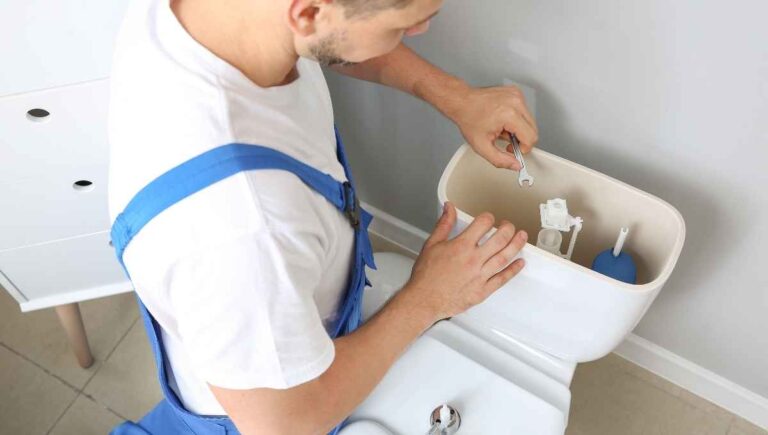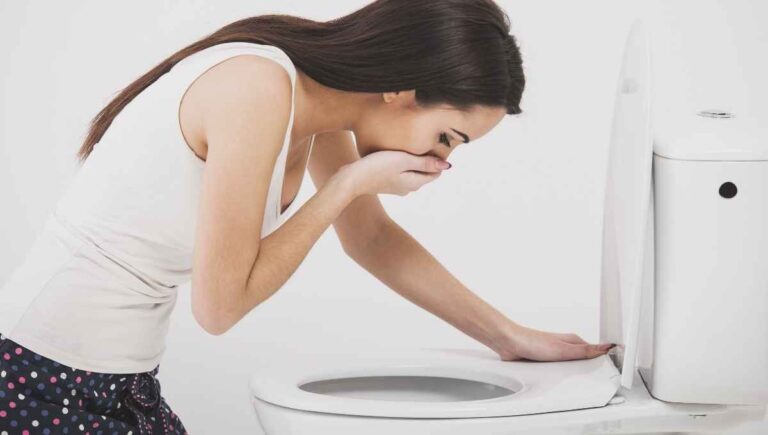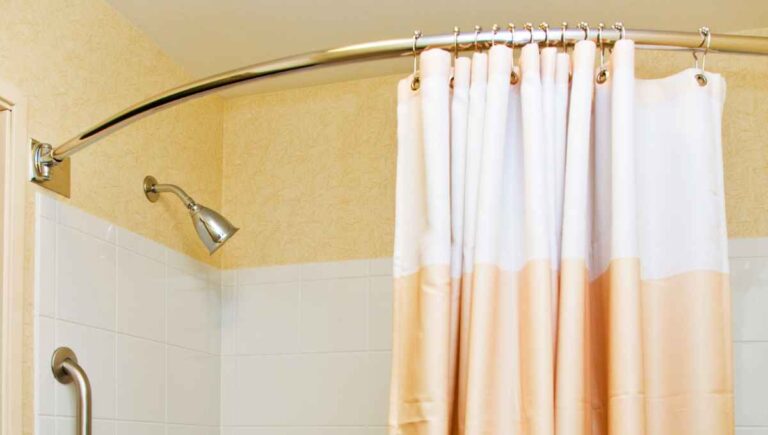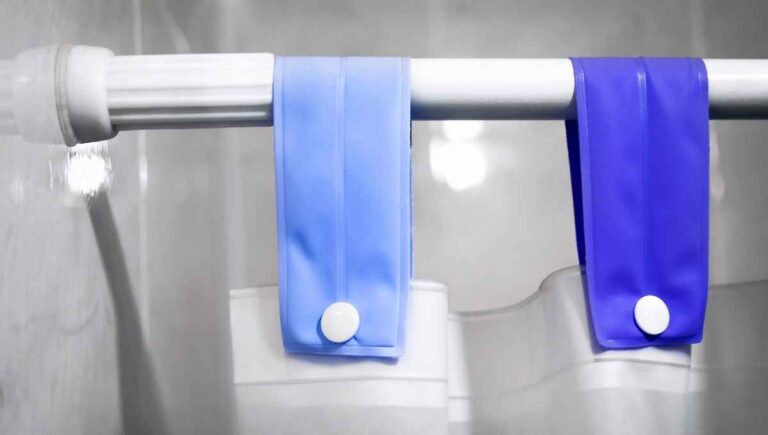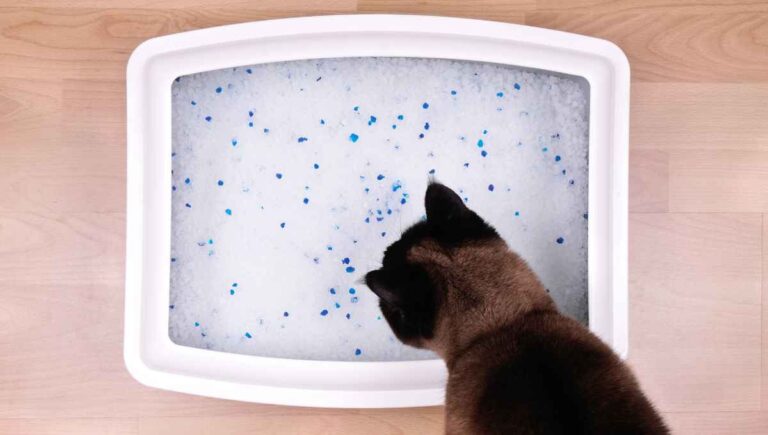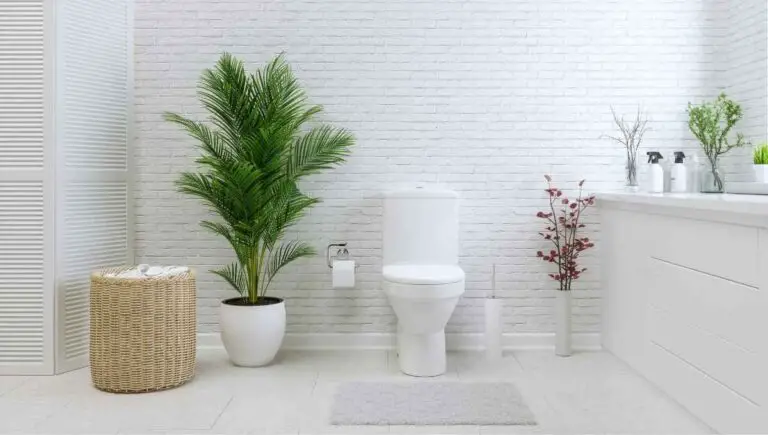Are Bath Mats Unsanitary? (Tips for Keeping Them Sanitary)

Bath mats are cute, trendy, and a great way to save your feet from touching the cold bathroom floor. But just because they’re a bathroom staple doesn’t mean they’re totally harmless. Considering everything they deal with throughout the weeks, are bath mats unsanitary?
Bath mats are not unsanitary if they are cleaned regularly. Regularly cleaning bath mats helps ensure they don’t grow mold, bacteria, or mildew, keeping them grime-free. Rug or carpet-like bath mats are especially prone to becoming unsanitary without regular washing.
Bathrooms have to deal with a lot of gross stuff, but they’re also where you go to get clean. It makes sense that bath mats can be on either end of the spectrum, gross or clean, depending on how well you take care of them.
But don’t worry, bath mat care isn’t hard once you get a few things straight. Let’s dive in!
This post contains affiliate links. This means Household Blogger may earn a commission should you make a purchase using any of our links. Please refer to our full affiliate disclosure policy for full details.
Here’s a Quick Pro Tip!
Bath mats are often unsanitary because they aren’t cleaned often enough. This is very common amongst fabric rugs since other materials often have antibacterial properties that make them easier to clean or limit how frequently you need to clean them.
Here are some especially hygienic bath mats that will keep you sanitary and slip-free:
1. SlipX Diatomaceous Earth Bath Mat – Fossilized algae remains have never been so modern.
2. Teak Wood Bath Mat – Teak wood is antibacterial, long-lasting, and fashionable.
3. Bamboo Bath Mat – Bamboo bath mats are waterproof, but will keep you from slipping.
Bath Mats: Sanitary or Not
Hygiene goes hand in hand with bathrooms. At the same time, bathrooms can deal with more unhygienic things than any other room in the house, and bath mats are no exception!
What Is The Point Of a Bath Mat?
The point of a bath mat is to provide a place to stand after you step out of the bath or shower. They have multiple purposes, but the main ones are to prevent slipping, soak up excess splashes, and protect the surface of your bathroom floor.
Lots of people grow up with bath mats in their bathrooms, so they end up keeping bath mats in their own homes, too.
Another benefit of bath mats is that they add comfort to your bathroom by keeping your feet away from the cold floor in the morning or after a warm bath.
Some people also use bath mats purely for decoration, since they can add a pop of color and make the room seem longer or bigger, whether in the bathroom or another room! The possibilities are endless!
Should I Use a Bath Tub Mat?
Whether or not you use a bathtub mat is ultimately up to personal preference and situation. Having a bathtub mat is generally considered safer than not having one since they act as an anti-slip surface and can protect bathroom flooring.
Still, bathtub mats require semi-regular cleaning, which can make them inconvenient to use.
If you have a floor that is particularly prone to water damage, a bath mat that can soak up splashes could be a great idea.
They’re also wonderful for kids (who are always going to make a mess on the bathroom floor) and for anyone else who is especially prone to slipping.
As cute and comfortable as bath mats can be, the main appeal of a bathtub mat is that it’s safer.
Are Bath Mats Unhygienic?
Bath mats can become unhygienic if they aren’t cared for properly. Bath mats need to be cleaned regularly in order to stay hygienic because they can be a breeding ground for bacteria, mold, and mildew. So long as you manage the upkeep of your bath mats, they are perfectly hygienic.
Mats that soak up a lot of water but can’t air out quickly are the hardest to clean and the best place for bacteria to spawn.
Mold is no joke, so it’s always worth it to clean your bath mat regularly and make sure it stays dry enough that no bacteria will grow.
Are Bathtub Mats Unsanitary?
Bathtub mats can become unsanitary in certain conditions. If your bath mat stays damp for extended periods of time, it’s likely that it will be unsanitary because it will grow mold, mildew, and/or bacteria. Regular cleaning and airing out your bathtub mat will prevent it from becoming unsanitary
Like most things in the bathroom, the key to keeping bathtub mats clean and sanitary is by dedicating yourself to regular upkeep. It’s annoying, but it’s better than having a smelly, unsanitary mat!
The more often you clean your mat, the easier and quicker it will become.
Are Shower Mats Hygienic?
Shower mats can be hygienic, but they can also harbor dangerous bacteria and mold if they trap moisture and aren’t cleaned regularly. On the flip side, shower mats can also prevent bacteria from growing on your bathroom floor by soaking up excess water.
It’s really a tradeoff between a potentially unsanitary floor and a potentially unsanitary shower mat.
Overall, shower mats are going to be the more hygienic option if water regularly spills out of the shower/bath.
But no matter what you choose, it’s important to clean either the mat or the floor regularly.
You might also enjoy our post on How to Get Your Bathtub White Again
Do Bath Mats Hold Bacteria?
Bath mats can hold bacteria when used for a long period of time without a wash or when damp for long periods of time. Warm, moist environments are the ideal ecosystem for bacteria, so bath mats can easily become a home to a variety of microbes.
It’s important to remember that bath mats don’t just get dirty on their own. They become dirty and harbor bacteria over time, after being used regularly.
The best option for keeping bacteria out is simply to clean the mat every so often, especially if it’s a carpet-like mat or if it retains a lot of moisture.
Bath mats will be sanitary and relatively bacteria-free so long as you make sure you’re staying on top of regular cleaning.
Can Mold Make You Sick?
Mold can easily make you sick if you’re exposed to it for an extended period of time. This is especially true for people who are vulnerable for one reason or another. People with asthma, a mold allergy, and/or another respiratory disease are at more risk than others.
Even if you can’t see physical mold growth, you can tell that either bacteria or mold is an issue if you see unexplained staining or you can smell a strong, musty odor.
The smell is often described as similar to rotting wood or wet socks.
Why Does My Bath Mat Smell?
Smells coming from bath mats often arise because of mildew or other types of mold. Mold can be dangerous in addition to smelling unpleasant, so it’s important to take action if you notice your bath mat smelling.
Mildew is a type of mold, but it tends to be less dangerous than some other kinds of mold and it has a subtler, musty smell compared to the stronger odors that come from other mold varieties.
Mildew can still cause issues, so you shouldn’t ignore it!
If your bath mat doesn’t smell like mold, another possibility is that the smell is coming from pet urine or feces. It’s gross, but it happens!
Do Bath Mats Grow Mold?
Bath mats don’t always grow mold or mildew, but they can if given the wrong conditions. Mold needs water to grow, which means that damp environments can quickly become the home of mold. If kept relatively dry, mold shouldn’t be an issue in your bath mat.
Certain kinds of bath mats (like thick, carpet-like mats) are more prone to growing mold because they trap more water and take a longer time to air out.
It also depends on how humid your bathroom is.
Bathrooms that are high in humidity will naturally be more susceptible to growing mold, especially in places like bath mats that already tend to be prone to moisture.
How Do I Keep My Bathroom Mat From Molding?
The most reliable ways to keep your bathroom mat from molding are to air out the bathroom mat when it’s not in use and to clean the mat regularly. A mixture of vinegar and water kills bacteria and mold while airing out the bathroom mat will keep mold from growing because of the lack of moisture.
All molds require moisture to grow. A bathroom mat that is constantly damp is just begging to have a big mold problem!
Airing out your bathroom mat can be accomplished by several different techniques or multiple at once.
Three of the best options are to drape the mat over a hanger or a tub after use, shake out the mat, and place the mat in a dryer.
Make sure you read the care tag on your mat before you attempt to put it in a washing machine or drier, though!
Bath Mats That Are Hygienic And Sanitary
Now that we know how common it is for bath mats to get nasty, let’s take a look at which kinds of bath mats are the most and least sanitary.
What Can I Use Instead Of a Bath Mat?
Although there’s nothing that can actually replace the functionality of a bath mat, there are alternatives to fabric bath mats. The main non-fabric materials that bath mats can be made from include bamboo, stone, cork, teak wood, and Vetiver root.
You can also consider installing slip-resistant wet room flooring or a slip-resistant tub base.
Each material has its own pros and cons to use, but they’re all great options if you’re sick of your fabric bath mat.
In the case that you simply don’t have a mat at all and you can’t purchase one, you can use towels in place of a bath mat.
We understand how painful the price tags on quality bath mats can be! Just make sure to wash and dry out your makeshift towel mat regularly.
What Type Of Bath Mat Is Most Hygienic?
Many bath mats could be considered the ‘most hygienic’, depending on how you look at them. The best materials for a hygienic bath mat are cotton for fast-drying fabric mats, cork, and Teak wood. Wood is naturally antibacterial and is easy to clean or dry with a single wipe.
Bamboo is often touted as a hygienic bath mat material, but it actually can become the home to many kinds of bacteria and mold.
It might be perfectly hygienic if you take good care of it, but it’s not naturally antibacterial like wood!
Some other specialty mats are also antibacterial, like this SlipX mat made of fossilized algae remains. We enjoyed this one for its sanitary qualities, but also for its cool design!
Are Cork Bath Mats Hygienic?
Cork bath mats are generally considered hygienic because they have natural antibacterial properties. Additionally, they dry quickly despite cork being a very absorbent material.
Just as the icing on the cake, cork bath mats happen to be environmentally friendly. And even without that extra incentive, they’re just a really great-looking mat to add to your bathroom’s decorum.
Are Bamboo Bath Mats Sanitary?
Bamboo bath mats can be perfectly sanitary. They aren’t necessarily the most sanitary bath mat material, but they do dry quickly and are generally waterproof. Since mold and bacteria grow in moist environments, these qualities help keep bathroom bath mats more sanitary than fabric ones.
One difference between bamboo bath mats and wooden mats is that Teak wood is antibacterial.
Bamboo bath mats don’t actually have any antibacterial properties aside from the fact that they’re waterproof.
The good news is that being waterproof will diminish the number of bacteria and mold that can grow. With regular cleaning, bamboo bath mats don’t have to be unhygienic!
How To Clean Your Bath Mats and Bathroom Rugs
You’re probably sick of hearing that cleaning your bath mats is important, but it really is! The only questions left now are how you’re supposed to clean them and how often they need to be cleaned.
How Often Should Bath Mats Be Washed?
Bath mats should be washed weekly, or more often if there are 3+ people using the shower and/or daily showers. It’s possible to only wash your bath mat bimonthly, but you should really wash it weekly to limit bacteria and mold growth.
A good rule of thumb is that bath mats need to be washed once every 3 to 7 uses.
The exact number varies depending on the type of bath mat you own and how much moisture tends to get soaked up by the mat.
How Often Should You Replace a Bathtub Mat?
Bathtub mats should generally be replaced once every 2-3 years. Bathtub mats that are less prone to bacterial and mold growth or wear and tear can stick around for longer.
For example, fabric bathtub rugs really should be replaced in 2-3 years. Teak wood, on the other hand, can last 10-15 years or even more.
A bathtub mat that has visible grime no matter how much you wash it is probably ready to be replaced.
You should also replace broken mats made of hard materials since they could potentially be a safety hazard and cause cuts, splinters, or abrasions.
Is It Okay To Wash Bathroom Rugs With Towels?
It’s perfectly fine to wash bathroom rugs with towels. In fact, towels or other rugs are the best items to wash alongside bathroom rugs. Be aware that bathroom rugs often shed a lot of lint, which can be an issue with regular clothes.
On top of that, a particularly dirty bathroom rug should probably be washed in isolation.
Unless you want all the dirt and grime from a bathroom rug to be cross-contaminated onto your towels, a super grimy rug shouldn’t be washed with towels.
Another possible reason you might not want to combine the two is if you’ve never washed the bathroom rug before and you’re not sure if it will bleed or not.
Always err on the side of caution. It’s better to know how your rug will act once it has been washed than to wash it and cause a mess!
You might also enjoy our post on If Toilet Lid Covers are Sanitary
Can You Put Rubber Bath Mats in the Washing Machine?
Rubber bath mats can go in the washing machine without causing harm to the mat. Unfortunately, though, it’s possible that putting a rubber-backed bath mat into the washing machine could cause harm to the washing machine’s drain motor and/or spin basket bearing over time.
Chances are, putting a bathroom mat into the washing machine will work fine.
But if you regularly wash your bathroom mat in the washing machine (for example, every week), then you might want to consider what could happen to your washing machine.
Why Do Bath Mats Go Yellow?
Bath mats turn yellow because of bacteria growth. The bacteria in question is likely Serratia marcescens, which is a generally harmless microbe that can be removed with a mixture of bleach and water. Mats that are more yellowish-orange might be the result of too much copper in the water.
It’s always good to hear that a kind of bacteria is non-harmful to us humans. In this case, the only thing Serratia marcescens is harming is the beauty of your bath mat!
For bath mats that are dealing with copper building issues, a mineral stain cleanser like the CLR Pro cleanser should fix the problem.
Can You Use Bleach On Bath Mats?
The majority of bath mats can tolerate bleach or vinegar. In fact, a mixture of bleach and water is often used on bath mats to clean out mold or bacterial growth. This isn’t the case for all mats, and you should always check the care tag on the bath mat to make sure you’re not doing permanent damage.
Bleach and vinegar can destroy the rubber backing on any bath mat that has it. Obviously, that’s a pretty big problem!
Even if the care tag doesn’t warn against it, a rubber-backed bath mat shouldn’t frequently be soaked in bleach (or vinegar, for that matter).
Hot water and certain essential oils have been known to get rid of bacteria, so those can be great alternatives to bleach/vinegar. Check the care tag!
Why Do Bath Mats Turn Pink?
If your bath mats or other bathroom fixtures are turning pink, it’s likely because of a bacteria called Serratia marcescens. This bacteria usually stains things reddish or pinkish, is water-borne, and generally is harmless.
Sometimes, Serratia marcescens stains things a yellowish color and not a pinkish one. Either way, it doesn’t usually pose a serious health issue.
You can remove the stains using a mixture of bleach and water or using a mixture of vinegar and water.
This bacteria is extremely common, especially in bathrooms. It grows just about anywhere in the home that’s warm and damp.
Related Questions
Should You Put a Rug In Front Of The Toilet?
Putting a rug in front of the toilet is fundamentally up to personal preference. Toilet mats tend to be even less sanitary than bath mats because of the sheer amount of bacteria that can breed there, which could be a reason not to purchase one.
Even regular bath mats can be home to bacteria and mold. Toilet mats, though, can have even more bacteria.
On top of that, toilet mats are mostly a comfort and style choice. If that’s worth it to you, then go for it- but otherwise, don’t bother!
Can Musty Towels Make You Sick?
Towels that have begun to take on a musty odor can definitely make you sick. Musty smells usually come from either mold or bacteria, both of which can be dangerous with prolonged exposure.
People who have asthma, allergies to molds, or other respiratory conditions are particularly vulnerable to sickness from mold or bacteria.
Musty towels should always be washed thoroughly before being used again to make sure you aren’t putting yourself or a family member at risk.
Final Thoughts
Bathroom mats are such a popular decoration that it’s unlikely we’ll ever stop using them, even though they can be unsanitary.
Thankfully, it shouldn’t matter whether you use a bamboo mat or a fuzzy rug. They can all be hygienic if cleaned regularly.
So, get out there and wash your bath mat– or buy one that works better for you!








